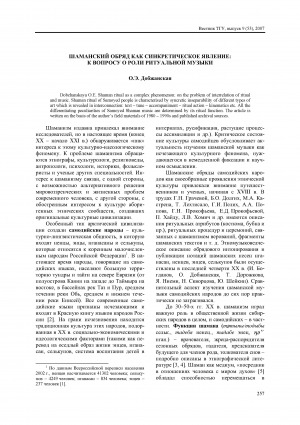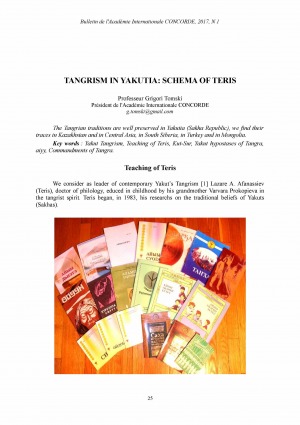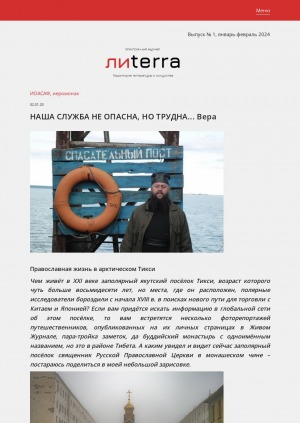Год выпуска: 2024
Количество страниц: 13 с.
Добжанская, О. Э. Шаманские фоноинструменты самодийских народов: типология в контексте ритуального функционирования / О. Э. Добжанская ; Арктический государственный институт культуры иискусств // Традиционная культура. - 2009, N 3 (35). - С. 92-104.
Количество страниц: 12 с.
Shaman music is the main part of musical culture of Samoyed peoples (Nganasans, Nenets, Enets, Selkups). In the lastquarter of XX century it became a subject of ethnomusicological research by I. Bogdanov, O. Dobzhanskaya, T.Dorozhkova, J. Niemi, N. Skvortsova, Ju. Shejkin. Shaman Music is conditioned by ritual functions and goals, all elements of shaman music (such as melody, rhythm,tempo, key etc.) are dependent on ritual purposes. The main features of Samoyed shaman music are the following: 1. Shaman singing is accompanied by the drum, which is the main ritual shaman’s attribute. 2. Shaman singing is a type collective responsorial singing: the solo part (performed by the shaman) alternates with the ensemble (or chorus) part, performed by the shaman’s helpers. 3. The basis of the shaman texts is 8-syllable verses. It is contrasted to 6-syllables verses, which were associated with secular genres of Samoyed music. 4. This 8-syllable pattern is materialized in the rhythm of shaman songs through certain rhythmical formulas. 5. Each shaman melody is a tune of the shaman’s helper-spirit, who has animal-like form. That is why the onomatopoeic sounds play a very important role in the musical composition of shaman rituals – the sounds of voices of a reindeer, a swan, a goose, a loom, a bear, a wolf are available to hear on recordings. 6. The musical form of shaman ritual is like a medley (or like beaded melodies of shaman’s helper-spirits). The musical form doesn’t have any fixed structure, it depends on the purpose and the plot of the ritual. Present research is based on author’s field materials of 1980-1990s and also on published and archive sources.
Добжанская, О. Э. Музыка шаманского обряда как языковая система = The music of shamanistic rite as a language system : (на примере самодийских народов) : (on the example of Samoyed languages / О. Э. Добжанская // Вопросы филологии. Урало-алтайские исследования. - 2009, 1/УА(1). - С. 31-42.
Количество страниц: 7 с.
Добжанская, Оксана Эдуардовна.
Шаманские обряды самодийских народов: к проблеме взаимосвязи музыки и ритуала / О. Э. Добжанская. - (Фольклор) // Гуманитарные науки в Сибири. - 2007. - N 4. - С. 102-105. Библиогр.: с. 105 (15 назв.).
Количество страниц: 6 с.
Добжанская, Оксана Эдуардовна.
Шаманский обряд как синкретическое явление: к вопросу о роли ритуальной музыки / О. Э. Добжанская. - (Гуманитарные науки. Искусствоведение) // Вестник ТГУ. - 2007. - Вып. 9 (53). - С. 257-262. Библиогр.: с. 262 (18 назв.).
Количество страниц: 12 с.
Scientific novelty. For the first time, based on unpublished archival ego-documents from the scientific heritage of G.V. Ksenofontov reveals the conflict between the intellectual and the official Soviet ideology in constructing a new language for describing reality within the framework of national discourse. The aim of the study focuses on the history of the formation of his cultural concept of the origin of Christianity as a world religion. In accordance with the aim, tasks were set to identify the circle of scientific opponents of G. V. Ksenofontov, systematization of the biographical facts of his cooperation with the “Union of militant atheists” on anti-religious propaganda, the study of the origin of religion and shamanism. Research methods. Based on the methodology of the “new biographical history” (social personal history), the model of the formation of the individual scientific strategy of G.V. Ksenofontov during the construction of the early Soviet society. Intellectual biography is reconstructed through the prism of socio-cultural analysis, which makes it possible to reveal the social context of space and time, the environment in which the scientific “picture of the world” of the scientist was formed. Results. Cross-cultural approach G.V. Ksenofontov to the study of historical processes was largely based on the works of the German ethno-geographical and cultural-historical school, the sociology of religion by E. Durheim and the methodology of historical materialism. A very important note in the researcher’s methodological discourse is an individual strategy for overcoming the conflict with the new government by using the basic provisions of Marxism-Leninism in his fundamental works. During the period of active atheistic propaganda (1927-1935), the scientist made presentations in the society “Godless” and the Research Buryat-Mongolian Society named after. D. Banzarova, publishes their works on the early religious beliefs of the peoples of Siberia. His ideas about the emergence of Christianity among the nomads of Eurasia, broad cultural comparisons of the figure of Christ with a shaman-prophet and symbolic interpretations gradually took shape in the original authorэs concept from the standpoint of cultural and historical conditioning. For the first time, pastoral tribes of Central Asia were nominated by G.V. Ksenofontov for the role of true bearers and keepers of Christian values. The scientist sets a new vector of research on nomadism: the steppe culture is the successor of an ancient civilization that once flourished in the countries of the Near East and Northern China with the Mongolian-Manchurian steppes. The theological concept of the scientist demonstrates a critical analysis of theological interpretations of religious texts. His extensive comparative studies in the field of Christianity explained theology not from idealistic positions, but relied on a new cultural and historical paradigm of humanitarian knowledge and personal experience in studying the early beliefs of the peoples of Siberia.
Романова, Е. Н. Теологическая концепция Г. В. Ксенофонтова: становление нового дискурса (1920‒1930) / Е. Н. Романова, Л. Б. Степанова ; ФИЦ "Якутский научный центр СО РАН" // Северо-Восточный гуманитарный вестник. - 2022. - N 4 (41). - С. 9-20. - DOI: 10.25693/SVGV.2022.41.4.001
DOI: 10.25693/SVGV.2022.41.4.001
Год выпуска: 2024
Год выпуска: 2024
Год выпуска: 2020









